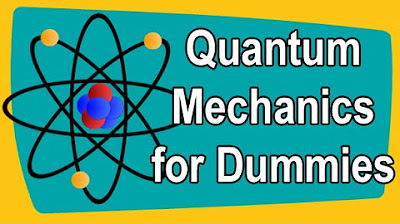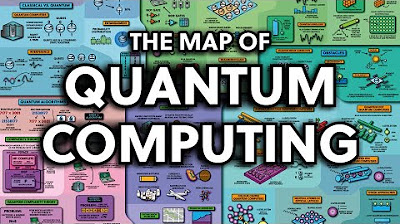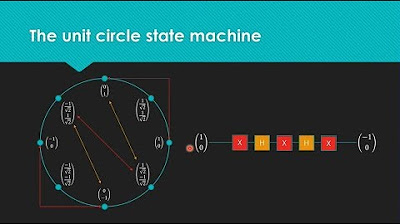The Map of Quantum Physics
TLDRThe video script provides an insightful overview of quantum physics, mapping out the subject's complex landscape. It begins with the historical development of quantum mechanics, addressing its foundational mysteries and key experiments like the double-slit experiment. The script delves into quantum phenomena, such as superposition and entanglement, and their implications for technology, including quantum computing and cryptography. It also touches on various research fields within quantum physics and the ongoing quest for a unified theory of quantum gravity. The video aims to demystify quantum concepts and encourage further exploration of this fascinating domain.
Takeaways
- 🌟 Quantum physics is a fascinating and complex field that has been shaped by the need to explain phenomena that classical physics could not.
- 📈 The development of quantum mechanics was driven by mysteries such as atomic spectra, the stability of atoms, radioactivity, blackbody radiation, and the photoelectric effect.
- 🧬 The double-slit experiment is a cornerstone of quantum mechanics, demonstrating particle-wave duality and the probabilistic nature of quantum events.
- 📊 Quantum mechanics describes particles as waves through wavefunctions, with their evolution governed by Schrödinger's equation and probability distributions derived using the Born rule.
- 🔍 The Heisenberg uncertainty principle and Bell's theorem are fundamental concepts that highlight the probabilistic and non-local nature of quantum mechanics.
- ⚛️ Energy quantization is a key feature of quantum mechanics, leading to the concept of zero-point energy and the specific behaviors of particles in atoms.
- 🌐 Quantum phenomena include superposition, decoherence, entanglement, and other behaviors unique to the quantum realm, such as tunneling, superconductivity, and the quantum hall effect.
- 🔧 Many technologies we use today, like lasers, atomic clocks, semiconductors, and MRI, are based on the principles of quantum physics.
- 🔬 Quantum information science is an emerging field with potential technologies like quantum cryptography, teleportation, and quantum computing that leverage superposition and entanglement.
- 🌌 Research in quantum physics spans various disciplines, including condensed matter physics, quantum biology, particle physics, and the pursuit of a unified theory combining quantum mechanics and general relativity.
Q & A
What was the main motivation behind creating the map of quantum physics?
-The main motivation was to share the fascinating subject of quantum physics with others, provide a structured layout of the ideas within the subject, set boundaries to its vastness, and introduce various concepts that one can delve deeper into if interested.
How does the geographical layout of the quantum physics map work?
-The map is laid out geographically where the northwest contains the foundations of quantum physics, moving southward through quantum phenomena to quantum technology. The southeast is dedicated to the academic disciplines of quantum physics, the center represents quantum theory, and the northeast looks at the theoretical future of quantum physics.
What are some of the key mysteries that led to the development of quantum mechanics?
-Key mysteries include the inability of classical physics to explain atomic spectra, the stability of atoms, the source of radioactivity, the mismatch between observed blackbody radiation and classical predictions, and the photoelectric effect which demonstrated particle-wave duality.
What does the double-slit experiment demonstrate about quantum mechanics?
-The double-slit experiment demonstrates the particle-wave duality in quantum mechanics, as electrons fired through two slits create an interference pattern characteristic of wave behavior, despite being detected as particles.
How does the Heisenberg uncertainty principle relate to quantum mechanics?
-The Heisenberg uncertainty principle states that quantum objects do not have definite values for certain pairs of properties, such as position and momentum. It highlights the fundamental probabilistic nature of the universe in quantum mechanics.
What is the significance of the Dirac equation in quantum mechanics?
-The Dirac equation extends the Schrödinger equation to include special relativity and is used to describe particles with high kinetic energy, playing a crucial role in understanding the behavior of particles at relativistic speeds.
What is entanglement in quantum mechanics and why is it important?
-Entanglement is a phenomenon where the wavefunctions of two or more particles interact and mix, causing them to become a single quantum object with correlated properties, even at large distances. It is important because it challenges our classical understanding of the world and is key to technologies like quantum cryptography and quantum computing.
How does quantum tunneling differ from classical particle behavior?
-Quantum tunneling allows particles to pass through narrow barriers that they classically shouldn't be able to due to their wavefunction's ability to penetrate through the barrier, a phenomenon that has no classical equivalent.
What is the role of quantum mechanics in the field of quantum biology?
-Quantum biology explores the role of quantum mechanics in biological systems, attempting to explain processes like the high efficiency of energy transport in photosynthesis, magnetoreception in birds, and the functioning of our senses, which are difficult to understand without quantum effects.
What are some of the technological applications that have emerged from our understanding of quantum physics?
-Technological applications of quantum physics include lasers, atomic clocks, semiconductor technologies like transistors and LEDs, electron microscopes, MRI techniques, and the development of quantum computers and quantum cryptography.
What are some of the main challenges in the field of quantum computing?
-The main challenges in quantum computing include engineering large groups of qubits that can maintain coherence long enough to perform computations and developing error correction methods to handle the fragility of quantum states.
What are string theory and loop quantum gravity, and why are they significant?
-String theory and loop quantum gravity are two main candidates for a grand unified theory that attempts to merge quantum mechanics and general relativity. They are significant because they aim to provide a comprehensive description of all fundamental forces and particles, which could potentially lead to a 'theory of everything'.
Outlines
🌌 Introduction to Quantum Physics
The speaker shares their passion for quantum physics and introduces a conceptual map designed to outline the subject. The map categorizes quantum physics into foundational theories, phenomena, technology, and academic disciplines, aiming to provide a structured understanding of the complex field. The speaker also mentions the availability of a poster version of the map and encourages viewers to explore the subject further through a dedicated playlist.
🚀 Historical Mysteries and Foundations
This section delves into the historical context that led to the development of quantum mechanics, addressing the discrepancies between observed phenomena and classical physics models. It discusses the mysteries of atomic spectra, atomic stability, radioactivity, blackbody radiation, and the photoelectric effect. The speaker then explores the foundational experiments and principles of quantum mechanics, such as the double-slit experiment, wavefunction, Schrödinger equation, the Born rule, Heisenberg uncertainty principle, Dirac equation, Bell's theorem, and energy quantization.
🌟 Quantum Phenomena and Properties
The speaker outlines various quantum properties and phenomena, including spin, superposition, decoherence, entanglement, non-locality, quantum tunneling, superconductivity, superfluidity, quantum hall effect, and the Casimir effect. It explains how these phenomena transition the quantum realm into our macroscopic world and touches on the concept of phase transitions in quantum systems. The section also highlights the technological applications of quantum physics, such as lasers, atomic clocks, semiconductors, electron microscopes, MRI, and quantum information technologies like cryptography and teleportation.
🔬 Fields of Quantum Physics Research
This part of the script discusses the various research fields within quantum physics, including condensed matter physics, quantum biology, cold atom physics, quantum chemistry, nuclear physics, particle physics, and theoretical physics. Each field is briefly described, highlighting their areas of focus and contributions to the broader understanding of quantum physics. The speaker also mentions unsolved problems in these fields and the potential for future discoveries, emphasizing the complexity and endless avenues of study in condensed matter physics.
🌐 Quantum Theory and Future Directions
The speaker concludes with an overview of quantum theory, touching on its core postulates, the path integral formulation, Hilbert spaces, and the symmetries that govern particle interactions. It addresses the current limitations of quantum physics, particularly the interpretations of quantum mechanics and the measurement problem. The script also explores theoretical efforts to reconcile quantum mechanics with general relativity, mentioning string theory and loop quantum gravity. The speaker encourages further learning and provides resources for those interested in deepening their understanding of quantum physics.
📚 Additional Resources and Acknowledgements
In the final paragraph, the speaker provides additional resources for learning quantum physics, including a website for interactive learning and a poster version of the quantum physics map. The speaker acknowledges the contributions of sponsors, collaborators, and supporters, and encourages viewers to engage with the content through Patreon and future videos.
Mindmap
Keywords
💡Quantum Physics
💡Wavefunction
💡Heisenberg Uncertainty Principle
💡Quantum Entanglement
💡Quantum Tunneling
💡Superconductivity
💡Quantum Computing
💡Quantum Cryptography
💡Quantum Simulation
💡Condensed Matter Physics
💡Particle Physics
Highlights
The creation of a map of quantum physics to outline the subject and its concepts, providing a structured approach to understanding its complexity.
The historical development of quantum mechanics from the late 1800s and early 1900s, stemming from the mismatch between reality and classical physics models.
The double-slit experiment as a cornerstone in quantum mechanics, demonstrating particle-wave duality through the interference pattern produced by electrons.
The wavefunction and Schrödinger's equation as fundamental mathematical descriptions of quantum particles and their evolution over time.
The probabilistic nature of the universe as described by quantum mechanics, with the Born rule for predicting the probability distribution of particle locations.
Heisenberg's uncertainty principle, which states that certain pairs of properties, like position and momentum, cannot have definite values simultaneously.
The Dirac equation, extending Schrödinger's equation to include special relativity and describe particles with high kinetic energy.
Bell's theorem, proving that the uncertainty in quantum mechanics is fundamental and not due to hidden variables, and introducing the concept of non-locality.
Energy quantization in quantum mechanics, explaining the discrete energy levels of electrons in atoms and the origin of the term 'quantum'.
Quantum phenomena such as superposition, entanglement, and decoherence, which describe the unique behaviors of particles at the quantum level.
Quantum tunneling, superconductivity, and superfluidity as examples of phenomena unique to quantum systems.
The application of quantum mechanics in technology, including lasers, atomic clocks, semiconductors, and MRI techniques.
Quantum information technologies like quantum cryptography, teleportation, and quantum computing, which utilize superposition and entanglement.
The various academic disciplines within quantum physics research, such as condensed matter physics, quantum biology, and particle physics, each with its unique focus and challenges.
The theoretical frontiers of quantum physics, including the interpretations of quantum mechanics and the quest for a grand unified theory combining quantum mechanics and general relativity.
The potential of quantum simulation for discovering new materials and solving complex computational problems.
The sponsorship of the video by Brilliant, a resource for learning math and science with interactive courses, and the offer for a discounted subscription.
Transcripts
Browse More Related Video
5.0 / 5 (0 votes)
Thanks for rating:





